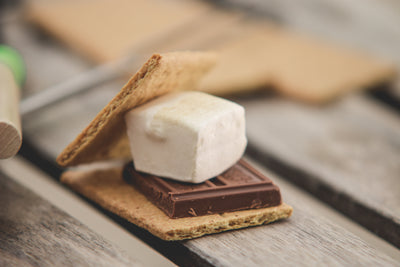Last year, with everyone self quarantining across the country and all of our favorite parks closed, we kicked off National Camp at Home Day. We loved seeing the creativity you brought to your at-home campsite, and we couldn’t wait to bring the fun back. This year for National Camp at Home Day, as your favorite camping spots slowly begin to reopen and people are starting to travel safely again, we’re focusing on preparedness. Think of National Camp at Home Day as the perfect occasion to pull out all the gear and have a trial run before setting out on the next big adventure. Over the coming weeks, we’re going to lay it out for you: how to choose the right shelter, tips for gear prepping, perfect recipes for the Dutch oven, and everything in between. So hang the hammock, grab some fresh batteries for the headlamp, and settle in: the adventure starts here.
If you’ve never been camping before, even the thought of walking into an REI can feel intimidating. With so much jargon tossed around and gear to research, the knowledge needed to make an overnight trip successful can seem overwhelming. It shouldn’t feel this way. Let’s get back to the basics, starting with styles of camping.
Basecamp or Backcountry?
You can think of Basecamp as the drive-in spot at your favorite national or state park. You’ll usually have the ability to bring more of the comforts of home, like comfy camp furniture and a broader kitchen setup, and you’ll still have access to the beauty of a place like Big Bend or Great Smoky Mountains National Park. If you’re new to camping, this can be an easy introduction into the world of overnights. We recommend considering what your future goals are, and if backcountry camping is something you want to work towards, think about buying gear that can be used for both applications. No matter how you want to kick things off, there’s nothing wrong with starting small and working out the kinks. Basecamp can have awesome benefits like proximity to water and electricity while still being close to beautiful trails worth exploring.
Backcountry, on the other hand, means you’ll be packing everything in on your shoulders, so a lot more attention must be paid to the weight of your kit. There are exceptions as well, like bikepacking and river trips, but for now we’re going to stick with these two basic categories. Backcountry camping can seem like another beast entirely, but with practice, it doesn’t have to be. There won’t be room in your pack for luxury items you might take to Basecamp, but the tradeoff is you can find yourself in remote places with spectacular views. Not to mention, the crowds disperse as you get further away from park headquarters. Backcountry camping allows you to cover ground efficiently and do things you may not be able to otherwise, like making a long, multi-day trek or waking up to an epic sunrise in the Tetons.
What shelter is right for you?
No matter where you plan to lay your head in the woods, you’re going to have to choose a shelter. Each shelter has its advantages, and you’re going to have to weigh the pros and cons and decide what’s right for you and for the environment you’re camping in.
First up: Tent camping. If you’re imagining yourself camping, this is probably what comes to mind. Tents offer considerable protection from the elements, are fairly easy to set up, and work virtually everywhere. Some drawbacks to consider are longer setup and teardown times, added weight in your pack in some cases, and their susceptibility to getting dirty inside or wet from condensation. Also keep in mind that finding the perfect tent site in the backcountry, or even while car camping for that matter, isn’t always so simple. You’ll often end up with a rock in your back or on an annoying slope that sends you sliding to one side of the tent all night. Still, it’s hard to beat the dependability of a faithful tent.
Next: Hammock camping. No more long setups before sitting down to enjoy a meal, and you can forget about that rock in your back as well. With the addition of rainflies, bug nets, and plenty of insulation, you’ll feel right at home in virtually any conditions. A huge bonus is the level of comfort you’ll enjoy while sleeping in a hammock—the days of crawling out of your sleeping bag with a stiff back are over! There are downsides to consider, the most obvious being the question of where to hang your hammock. Camping in the desert is likely not an option, and although it’s rare, some parks ban the use of hammocks altogether. It’s always best to check for regulations before making any decisions about how you’ll utilize a park. Bottomline, with the right amount of trees, hammock camping is a solid option.
For our grand finale: Cowboy camping. Everyone’s dreamed of sleeping under the stars, and with modern sleeping pads and camp quilts, you’ll sleep more comfortably than John Wayne ever thought possible. A key advantage comes into play after a long day on the trail when all you want to do is crawl inside your sleeping bag. Cowboy camping makes setting up camp as simple as possible so you can focus on the fun parts, like stuffing your face with granola bars and hiking until your heels bleed. Another huge plus as more and more of us move into light-polluted cities is the view of the stars without a rainfly or bugnet overhead. Drifting off to sleep with unmatched views of the Milky Way is an experience that’s truly hard to beat. Before we romanticize this too much, consider that cowboy camping leaves you exposed to the elements—bad weather and critters alike. The last thing you want to face in the middle of a deep sleep is a rain-soaked or scorpion-infested sleeping bag. Still, when implemented in appropriate conditions, cowboy camping can be the perfect way to enjoy the outdoors.
If you’re still trying to decide what shelter is right for you, or even if you’re a longtime camper curious about a new setup, National Camp at Home Day is the perfect opportunity for a trial run. In the field, you want to be as familiar as possible with your gear to make setting up camp a breeze. Practice pitching camp at home so when the weather turns south and the wind and rains come, you’re able to get out of the elements and into your warm sleeping bag as quickly as possible.
To learn more about hammock camping, check out these two blogs:
Four reasons to make Mantis your go-to sleep system
Hammock Camping 101





